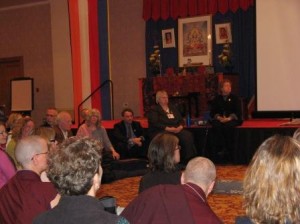Sunday
Community ArticlesBringing Conflict to the Path
A Gateway to Enlightened Society, By John Fox
As a participant in the 2009 Congress, John Fox returned from Halifax inspired, and also eager to continue a dialog begun there concerning how to bring conflict and differing points of view to the Path. The particular breakout group John participated in convened over two and a half days, and was asked to address the question ‘How do we work with conflict and/or different points of view in our community?’ John offers the following summary in the hope that this important topic will continue to be discussed and contemplated. Concrete suggestions for how to move forward also emerged and are described below.
THE GROUND
‘Many of us in the Shambhala sangha are deeply concerned about lines that are forming or formed in relation to areas of conflict in our community.’ It was this passionate concern, this question, that formed the basis and drove the enquiry and discussion in our break-out group at this years congress in Halifax. We were asked to consider the issue of conflict in our community and to what extent we were dealing/not dealing with the issue’s. Out of this question a two and a half day conversation arose.
Many of us were raised with the attitude that conflict is a problem, that differing views are to be gotten rid of. This particular approach did not form the ground of our discussion. What quickly surfaced, as the agreed upon ground, was that conflict although sometimes painful and potentially divisive was an intelligent response to many of the changes taking place in our community. To state this differently we could say that what is emerging is an understanding of the richness and insight contained in our conflicts and differing views.
THE PATH
With conflict seen as potential enrichment what are some of ways we can embody or practice this view?
1. Recognition that the tools of warriorship are at times forgotten and that the old habit of having to be right takes precedent. An example of not provoking your warriorship is to be in a situation that is conflicted and choose to discuss with everyone else the problem but to be hesitant or fearful in bringing it to the attention of the appropriate person(s).
2. Individuals are recognizing that the hidden conflict, the one that is not spoken of, takes up a lot of energy and saps lungta. We could say that when we take warriorship as our path we will experience conflict as being more and more difficult to both indulge in and to hide from.
3. Shambhala chauvinism. The tendency at times, to expect that because we are Shambhalian we are precluded from having to work thru our rather human issues.
4. Recognition that we need to educate our community on current policy(s) and procedures already existent and which in some instances will both help deflect conflict and assist in working with conflict when it arises. For example if conflict arises in the area of Practice & Study we have Practice & Study Guidelines as a reference or should the conflict arise in other areas such as domestic we have The Care & Conduct Guidelines that have been created. It was recognized in our discussions that these already existent works can be of benefit in a couple of ways:
• They can provide new information to individuals that may ‘shed new light’ on the potentially conflicted area.
•When heat and controversy is already existent in a situation, having known guidelines and policies as references can assist in reducing potential further conflict. Stated differently, when individuals have the ability to relate to some already existent guideline(s), process’s, or well developed thought, the affect may be less emotional fire and more space for the cool quality of rational thinking and intelligence to take place.
How can we go forward?
1. Discussions held at regional and local levels will provoke deeper understanding. An example of this would be to develop contemplations in the area of conflict and provide forums were contemplations would be practiced and discussed. The intent is to provide real situations for people to develop their own set of skillful means when dealing with conflict.
2. The ability to have access to more tools and resources that can assist and support us in working with our ‘richness of difference’. In other words there are many skillful means that have been developed. What are they? Where are they? The approach here is we can learn from existing wisdom.
3. More clarity and education related to the resources we have already developed in addressing the areas of conflict and conduct issues. This would include reviewing and updating current resources. An outcome would be that all of our guidelines and resources would be available on the web.
4. Web services could include resources such as mediation services. A mediation template could be conceived and posted on the Shambhala web site. This would provide an excellent first step in helping individuals and/or groups with conflict issues.
5. More procedures in place for specific conflict situations. An example might be having a regional voice or office that can provide information and direction when needed, for instance consideration of reforming the Upaya Council as well as consideration of appointing regional ombudsmen.
6. Celebrate our differences rather than having them polarize us.
7. Developing non-conceptual ways to work with conflict. An example of a non-conceptual way to work with conflict could be found in an expression of a Shambhala Art form. OR The understanding and practice of ‘deep listening’ might be a way to initiate a new process in managing conflict. The intent here is to consider the tools we have as Shambhalians and assess their value; if there is perceived value, use them.
As part of our presentation to the larger congress we were invited to create a poem or a statement that captured our discussion. In our case the following poem by one of our group captured the view.
Inseparable from Basic Goodness
Conflict is
Leaning in with warriorship.
Conflict is
The gateway to enlightened society.



















Mar 17, 2010
Reply
Addressing conflict in a practical constructive way is essential. Excellent post. Keep it up.